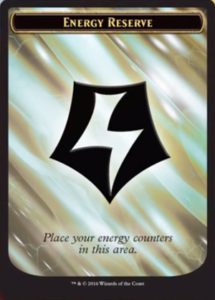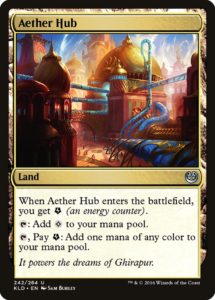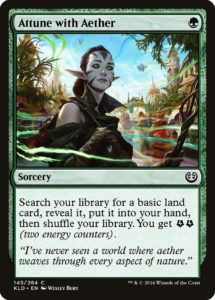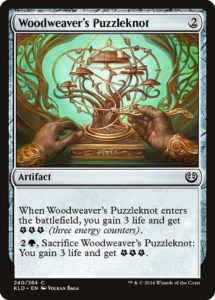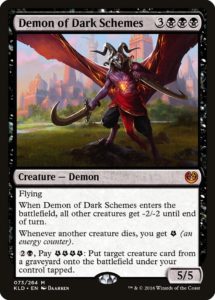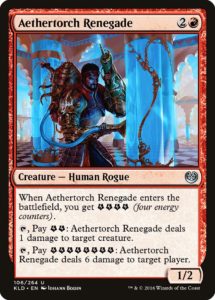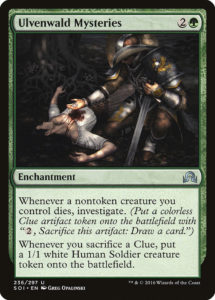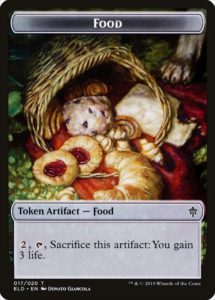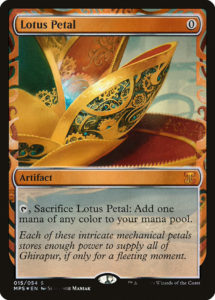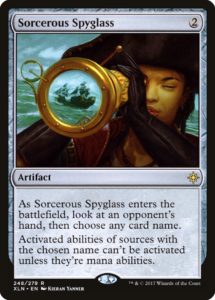Magic is a game the needs to constantly be innovating. With over a quarter century of history and well-mined design space, it becomes increasingly difficult for it to find the balance between novelty and remaining Magic. One of the biggest developments in recent years has been the embracing of alternate resource mechanics—new economies that function in addition to and in conjunction with the mana system. We’ve seen this with artifact tokens in Clues, Treasures, and Food, but we’ve also seen this with Energy. (Magic has also toyed with additional counter resources like Experience and Poison counters).
It’s well-established what one can approximately get for any given amount of mana, at any given rarity or intended power level. It’s been demonstrated that power tends to outpace mana cost at a certain point (7+ drops are just allowed to be much stronger than a 4 drop plus a 3 drop, since 7 is so difficult to get to). However, what can we learn from these alternate resource systems? Just what is a single unit of each of them worth? And what does this tell us about how they compare with each other?
The Big One
Let’s start with the largest alternate resource mechanic, Energy. Energy is the lone system that has no intrinsic use, since Treasures, Clues, and Food all innately convert into other resources. Energy is also chief at circumventing the mana system—getting energy usually entails paying mana for a spell, but spending it rarely requires mana.
Let’s note that we are ignoring the additional cost of the energy converter and producer—Aetherwind Basker is harder to get out than Voltaic Brawler while consuming energy at the same rate, and Eddytail Hawk produces energy for less mana than Consul’s Shieldguard. We need the lines need to be drawn somewhere, and our primary interest is in what bang you get for your buck at each spot on the curve.
One Energy
There are more options for using a single pip of energy than any other amount. The most common use is temporarily modifying a creature:
- +1/+1—Aetherwind Basker
- +1/+1 and trample—Voltaic Brawler
- +2/+0—Aetherstream Leopard
- +2/-2—Shipwreck Moray
- -2/+2—Multiform Wonder
- Lifelink—Aethersphere Harvester
- Flying—Eddytail Hawk
- Vigilance—Multiform Wonder
- Indestructible—Consul’s Shieldguard
- Haste—Spontaneous Artist
- Can’t block—Maulfist Doorbuster
- Tap a creature or planeswalker and shut off its abilities—Deadlock Trap
- Filter a mana of any color—Aether Hub
- Make a mana of any color—Servant of the Conduit
- Scry 1—Aether Theorist
- Mill 3 —Minister of Inquiries
For a single energy, you’re generally getting an effect worth less than a mana. It’s something you’d find on a charm, an ETB effect, or with an added benefit attached. This makes sense, since energy is usually produced in batches of 2-3, and if a single energy were worth a mana’s worth of effect, a card would basically have to cost 1 extra for each energy it produced.
Two Energy
Two energy is where you start getting permanent benefits:
- 1/1 Servo token—Aether Chaser and friends
- +1/+1 counter—Longtusk Cub
- +1/+1 counter and tap a creature—Aetherstorm Roc
- Draw a card and lose 1 life—Glint-Sleeve Siphoner
- Blink this—Aethergeode Miner
- +2/+2 until end of turn—Riparian Tiger
- 1 damage to target creature—Aethertorch Renegade
- Auriok Replica‘s ability—Consulate Surveillance
- Each opponent loses 3 life. You gain that much life—Gonti’s Machinations
- Ignore defender until end of turn—Hightide Hermit
- Twiddle an artifact or creature—Janjeet Sentry
- Retain an undercosted creature—Lathnu Hellion
We’re still in the realm of minor effects, but we’re getting close to a card’s worth of value. That said, there’s also a wide disparity in effect and context; Aethertorch Renegade‘s effect is weak on a spell but incredibly potent on a repeatable source of damage.
Three Energy
At three energy, you start getting a card’s worth of effect. While a thopter or a card on its own aren’t worth more than a mana, getting that effect repeatedly is worth quite a bit more.
- 1/1 flying thopter—Whirler Virtuoso
- Draw a card—Shielded Aether Thief
- +1/+1 counter and hexproof until end of turn—Bristling Hydra
- 2 damage to an opponent—Consulate Turret
- Double power and toughness until end of turn—Electrostatic Pummeler
- Culling Mark—Peema Aether-Seer
Four Energy
In the 4+ Energy range, you start getting wildly different and dramatic effects. They still tend to cost more in energy than they do in mana (with the semi-exception of Summoning Trap), but this makes sense considering how much energy can be generated in a deck dedicated to doing so.
- Rescue—Aethertide Whale
- Rise from the Grave—Demon of Dark Schemes (also requires 2B)
Five Energy
- Three damage to any target—Dynavault Tower
Six Energy
Eiight Energy
- Evacuation—Aethersquall Ancient
- Inferno Jet—Aethertorch Renegade
- Cowl Prowler—Architect of the Untamed
- Time Walk—Gonti’s Aether Heart
- Relentless Assault—Lightning Runner
X Energy
- Gain control of an artifact or creature with CMC X—Confiscation Coup
- -X/-X until end of turn Die Young
- X damage to a creature—Harnessed Lightning
And that’s every use for energy, the most versatile and varied of all resources discussed today. It can do most effects in Magic, and while it does nothing by itself, the sheer array of options it affords makes it a powerful and dangerous mechanic.
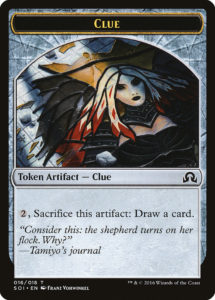 Get a…
Get a…
Clues were the first heavily used artifact token in Magic, and they provide one of the most valuable resource in the game: cards. They convert into cards at about the same rate that adding a cantrip to a spell costs: 2 mana. This intrinsic value means they convert into far fewer things than does Energy and we start seeing cards that care about Clues existing or piggyback on them being cracked.
One Clue
- Draw a card (also requires 2 mana) (This cost 3 Energy.)
Three Clues
This is an effect we didn’t see in Energy (likely for good reason, since an Energy tutor could find more energy producers to keep going). It also requires less resource than one would expect based on the Energy economy. This makes sense, since Clues are more expensive to produce than Energy and there’s a much bigger cost to spending three Clues in lost cards.
Bonuses from having Clues
- +X/+X until end of turn—Confront the Unknown
Bonuses from cracking Clues
- 1/1 token—Ulvenwald Mysteries (This is worth ~2 Energy)
- +1/+1 counter—Tireless Tracker (Same here)
- Mill 3—Fleeting Memories (This is worth 1 energy)
- Three Life—Graf Mole (This is worth 1 Food, but that’s getting ahead of ourselves.)
- Play a creature for free—Briarbridge Patrol (requires 3 clues)
Clues are strongly encouraged to be converted into cards, rather than other resources. This will not hold true for Food.
Om nom nom
Food looks far less impressive when compared to Clues. Life is a vital resource in Magic, but cards that merely gain life tend to be weak while card drawing is highly prized. Consequently, there are more uses for Food than there are Clues, and players are encouraged to eschew eating Food to gain a benefit other than life.
One Food
- Three Life
- One mana of any color—Gilded Goose
- Reanimate a Cauldron Familiar
- +2/+2 until end of turn—Insatiable Appetite
- Hunt Down—Maraleaf Rider (Peema Aether-Seer did a similar effect for 3 energy)
- +1/+1 counter, indestructible, and tap—Wicked Wolf
- -3/-3 until end of turn (requires 2B)—Bog Naughty (This is worth ~3 Energy.)
- Nessian Courser—Oko, Thief of Crowns
Sure, Oko stretches how we’re defining engines, but I’m including it because it is so evidently a part of Oko’s intended play pattern.
Two Foods
-
- Vorstclaw—Giant Opportunity
- Draw a card—Savvy Hunter
- Lava Spike—Tempting Witch
Giant Opportunity is close to Architect of the Untamed. Yes, she generated her own energy and had a repeatable effect, but isn’t it fascinating that 2 Foods yields almost the same result as 8 Energy?
Three Foods
- Reanimate Feasting Troll King
Bonus from eating Food
- Sleight of Hand for permanents (requires 1 mana)—Trail of Crumbs
Food is a distant second to Energy in its utility, but it still affords a wider diversity of effects and more encouragement to be so used than do Clues and Treasures.
To see the world in a grain of sand…
Treasure is the most inherently dangerous alternate resource mechanic and this restraint is evident in its limited utility. Adding a Lotus Petal to a card seems to add close to one mana to the cost, which more generosity at the top of the curve (where the value of mana acceleration sharply drops). Treasure was also the most minor alternate resource mechanic, adding to its limited exploration.
One Treasure
- One mana of any color
- Draw a card—Treasure Cove
Drawing a card costs 3 energy, 2 Foods, and 1 Clue + 2 mana. It’s also an unreasonably efficient resource conversion, given that it requires several turns of effort.
Three Treasures
- Draw a card—Ruthless Knave
This is the first time we’re seeing two identical effects at different costs. It makes sense, not only because Ruthless Knave is less pushed than Treasure Map, but also because it requires far less work to get this engine online.
Ten Treasures
- Win the game—Revel in Riches
We’ve arrived at the most dramatic effect possible in a game of Magic, and one we could never see with something as plentiful as Energy. The restraint inherent in the mechanic’s use is probably the reason why it could be used for an alternate win condition. Any of the other mechanics would be too easy to achieve such a condition with or require a ludicrously large number of units to do so.
Bonus for having Treasure
- +1/+1—Deadeye Plunderers
Bonuses from cracking Treasure
- +1/+0—Captain Lannery Storm
Looking back to see ahead
Each of these four resources has their own quirks. Clues provide the most universally desirable resource and Treasure the most dangerous resource. Food has to provide more options because of its more limited utility, while Energy provides vastly more because it has no utility on its own. We’ve seen several effects across multiple resources (like producing a mana of any color or making 1/1s) while plenty of rewards unique to each resource type.
One wonders where Magic will go next. It makes sense that Food and Clues both require two mana—one is often an insignificant cost, so the resources will rarely hang around, while three is a hefty cost (something Counterspell and Doom Blade lovers know full well). How much would a card have to Scry to justify a two mana cost, and would that event make good gameplay? It’d add a lot of micro-decisions to each game, and Food has already proved problematic in lengthening games.
Would a format full of Origin Spellbombs be good, or would a surplus of 1/1s just make for cluttered board states and make us wish for Amass? There are only so many minor effects in Magic and fewer still that are worth doing repeatedly (and with the added restriction of probably requiring two mana). Hopefully, we’ll get the chance to find out soon enough, or perhaps we’ll simply get to see any of these four mechanics return again and add more data points of how they resemble or diverge from one another.
And, as always, thanks for reading.
—Zachary Barash is a New York City-based game designer and the commissioner of Team Draft League. He designs for Kingdom Death: Monster, has a Game Design MFA from the NYU Game Center, and does freelance game design. When the stars align, he streams Magic (but the stars align way less often than he’d like).

